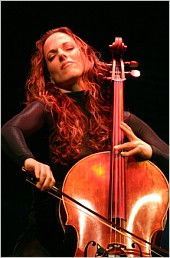October 23, 2006
____________________________________________________________
 The Washington Post 10/23/06: Maya Beiser -- the hot young cello diva of the avant garde – is on a mission. Forget the traditional offerings of Bach and Brahms – Beiser puts together hip, global programs of purely 21st Century music, pushing the cello to its limits. She embraces amplification, revels in multi-media and likes to punch up the bland stage of the recital hall with visual drama. Her musical appetite is as wide as it is voracious, and top composers from Steve Reich to Osvaldo Golijov have lined up to write for her. In short, she’s out to shake the classical world by its neck -- to which we can only respond with loud and heartfelt cheers.
The Washington Post 10/23/06: Maya Beiser -- the hot young cello diva of the avant garde – is on a mission. Forget the traditional offerings of Bach and Brahms – Beiser puts together hip, global programs of purely 21st Century music, pushing the cello to its limits. She embraces amplification, revels in multi-media and likes to punch up the bland stage of the recital hall with visual drama. Her musical appetite is as wide as it is voracious, and top composers from Steve Reich to Osvaldo Golijov have lined up to write for her. In short, she’s out to shake the classical world by its neck -- to which we can only respond with loud and heartfelt cheers.
But as she showed at the Terrace Theater on Saturday night in her latest program, “Almost Human”, there’s a bit more shaking left to do. The central conceit of “Almost Human” is the closeness of the cello to the human voice, and most of the works on Beiser’s program explored that idea in interesting, sometimes compelling ways. “Khse Buon”, by the impressive Cambodian composer Chinary Ung, was vivid and and fiercely articulate, while Joby Talbot’s “Motion Detector” used amplification and tape loops to build a powerful and almost savage piece out of a few fragments of sound.
Other pieces, though, fell flat; Michael Gordon’s “Light is Calling” set long cello lines against a subtly distorted recorded background, while video by Bill Morrison pulsed on a huge screen. Like much of the evening, it was pleasantly mesmerizing rather than engaging, with little for the ears to engage.
And the centerpiece of the concert, Eve Beglarian’s “I am writing to you from a far-off country”, never got off the ground at all. Described as a “multimedia dreamscape”, the work called for Beiser to both play and recite a surrealist poem by Henri Michaux. But the music was self-important and drab, capturing none of Michaux’s subtle and butterfly-light imagery, and wasn’t helped by the excruciatingly dull video by filmmaker Shirin Neshat that unfolded heavily on screeens across the stage. The audience began sneaking out halfway through the piece -- and unfortunately, no one could blame them.